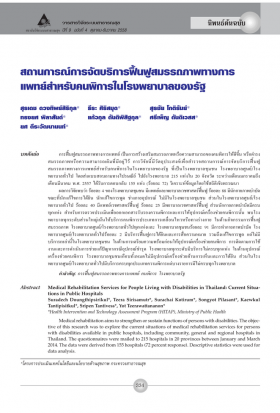สุรเดช ดวงทิพย์สิริกุล
ธีระ ศิริสมุด
สุรชัย โกติรัมย์
ทรงยศ พิลาสันต์
แก้วกุล ตันติพิสิฐกุล
ศรีเพ็ญ ตันติเวสส
ยศ ตีระวัฒนานนท์
Abstract:
การฟื้นฟูสมรรถภาพทางการแพทย์ เป็นการสร้างเสริมสมรรถภาพหรือความสามารถของคนพิการให้ดีขึ้น หรือดำรงสมรรถภาพหรือความสามารถเดิมที่มีอยู่ไว้ การวิจัยนี้มีวัตถุประสงค์เพื่อสำรวจสถานการณ์การจัดบริการฟื้นฟูสมรรถภาพทางการแพทย์สำหรับคนพิการในโรงพยาบาลของรัฐ ที่เป็นโรงพยาบาลชุมชน โรงพยาบาลศูนย์/โรงพยาบาลทั่วไป โดยส่งแบบสอบถามทางไปรษณีย์ ไปยังโรงพยาบาล 215 แห่งใน 20 จังหวัด ระหว่างเดือนมกราคมถึงเดือนมีนาคม พ.ศ. 2557 ได้รับการตอบกลับ 155 แห่ง (ร้อยละ 72) วิเคราะห์ข้อมูลโดยใช้สถิติเชิงพรรณนา ผลการวิจัยพบว่า ร้อยละ 4 ของโรงพยาบาลชุมชน มีแพทย์และพยาบาลเวชศาสตร์ฟื้นฟู ร้อยละ 88 มีนักกายภาพบำบัด ขณะที่นักแก้ไขการได้ยิน นักแก้ไขการพูด ช่างกายอุปกรณ์ ไม่มีในโรงพยาบาลชุมชน ส่วนในโรงพยาบาลศูนย์/โรงพยาบาลทั่วไป ร้อยละ 40 มีแพทย์เวชศาสต์ฟื้นฟู ร้อยละ 25 มีพยาบาลเวชศาสตร์ฟื้นฟู ส่วนนักกายภาพบำบัดมีครบทุกแห่ง สำหรับการตรวจประเมินเพื่อออกเอกสารรับรองความพิการและการให้อุปกรณ์เครื่องช่วยความพิการนั้น พบโรงพยาบาลทุกระดับส่วนใหญ่เน้นให้บริการคนพิการประเภทการเคลื่อนไหวหรือทางร่างกาย ในด้านกิจกรรมการฟื้นฟูสมรรถภาพ โรงพยาบาลศูนย์/โรงพยาบาลทั่วไปทุกแห่งและ โรงพยาบาลชุมชนร้อยละ 91 มีการทำกายภาพบำบัด โรงพยาบาลศูนย์/โรงพยาบาลทั่วไปร้อยละ 2 มีบริการฟื้นฟูการได้ยินและการสื่อความหมาย รวมถึงแก้ไขการพูด แต่ไม่มีบริการเหล่านี้ในโรงพยาบาลชุมชน ในด้านการเตรียมความพร้อมก่อนให้อุปกรณ์เครื่องช่วยความพิการ การติดตามการใช้งานและการดำเนินการช่วยแก้ปัญหากรณีอุปกรณ์ชำรุด โรงพยาบาลทุกระดับมีบริการไม่ครบทุกแห่ง ในด้านอุปกรณ์เครื่องช่วยความพิการ โรงพยาบาลชุมชนเกือบทั้งหมดไม่มีอุปกรณ์เครื่องช่วยด้านการเห็นและการได้ยิน ส่วนในโรงพยาบาลศูนย์/โรงพยาบาลทั่วไปมีบริการครบทุกประเภทความพิการแต่บางรายการมีไม่ครบทุกโรงพยาบาล
Abstract:
Medical rehabilitation aims to strengthen or sustain functions of persons with disabilities. The objective of this research was to explore the current situations of medical rehabilitation services for persons with disabilities available in public hospitals, including community, general and regional hospitals in Thailand. The questionnaires were mailed to 215 hospitals in 20 provinces between January and March 2014. The data were derived from 155 hospitals (72 percent response). Descriptive statistics were used for data analysis.The results showed that, at community level, physiatrists and rehabilitation nurses were employed in only 4% of hospitals; 88% of hospitals hired physiotherapists and there was no audiologist, speech pathologist and orthotic technician. There were physiotherapists working in all general and regional hospitals whereas physiatrists and rehabilitation nurses were found in only 40% and 25% of general and regional hospitals. The assessment of disability and prescribing assistive devices were mainly for persons with physical and mobility disability. The most common services were physiotherapy (100% in regional and general hospitals, 91% in community hospitals) while speech and hearing rehabilitation services were provided at the smallest proportion (2% in regional and general hospitals and no service in community hospitals). The services of training programs for using assistive devices, user follow-up and device repair were still missing in some hospitals. Visual and hearing aids were unavailable in community hospitals. Medical device services for all type of disabilities were provided in regional and general hospitals but some items of devices still were unavailable in some hospitals.





